Item 1: Report to Shareholders| Prime Reserve Fund | November 30, 2005 |
The views and opinions in this report were current as of November 30, 2005. They are not guarantees of performance or investment results and should not be taken as investment advice. Investment decisions reflect a variety of factors, and the managers reserve the right to change their views about individual stocks, sectors, and the markets at any time. As a result, the views expressed should not be relied upon as a forecast of the fund’s future investment intent. The report is certified under the Sarbanes-Oxley Act of 2002, which requires mutual funds and other public companies to affirm that, to the best of their knowledge, the information in their financial reports is fairly and accurately stated in all material respects.
REPORTS ON THE WEB
Sign up for our E-mail Program, and you can begin to receive updated fund reports and prospectuses online rather than through the mail. Log in to your account at troweprice.com for more information.
Fellow Shareholders
Money market securities produced positive returns in the six-month period ended November 30, 2005. Money market yields rose as the Federal Reserve continued to remove its accommodative monetary policy with four quarter-point increases in the fed funds rate during our reporting period, followed by another in mid-December.
ECONOMY AND INTEREST RATES
Conditions in the U.S. economy were favorable over the last six months. Economic growth as measured by gross domestic product (GDP) exceeded 3%, job growth was steady, and unemployment hovered around 5%. Fears of higher inflation and slower economic growth, however, picked up in recent months. Oil prices spiked in late August to $70 per barrel as Hurricane Katrina severely disrupted energy production along the Gulf Coast but settled below $60 by the end of November. In addition, consumer sentiment soured as gasoline temporarily surged above $3 per gallon and higher oil and natural gas prices presaged a significant jump in year-over-year heating costs this winter.
Federal Reserve officials acknowledged the economic uncertainty stemming from hurricane damage and elevated energy costs but concluded that the effects on the economy would be temporary and opted to continue raising short-term interest rates. From the end of May through November 30, the central bank methodically raised the federal funds target rate in four quarter-point increments from 3.00% to 4.00% —a level not seen in more than four years. The Fed raised the target rate another 25 basis points (0.25%) to 4.25% on December 13 for a total of 13 rate increases since June 2004, when the fed funds rate was 1.00% . As shown in the graph above, 90-day and six-month Treasury bill yields climbed steadily in the first half of our fiscal year, closely tracking the fed funds rate.

| THE FED’S ROLE AND WHAT IT MEANS TO YOU |
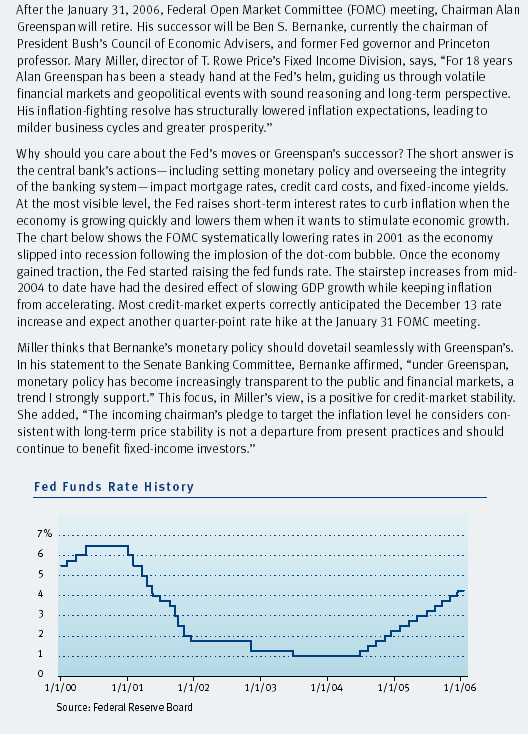
PERFORMANCE AND PORTFOLIO REVIEW
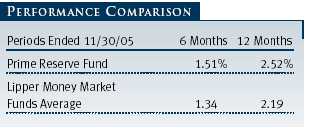
Your fund returned 1.51% and 2.52% for the 6- and 12-month periods ended November 30, 2005, respectively. As shown in the table, the fund surpassed its Lipper benchmark in both periods. While portfolio returns remain modest, they have increased in tandem with the fed funds rate. In fact, the fund’s most recent six-month return is more than a full percentage point higher than it was for the six-month period ended November 30, 2004.
The fund’s long-term performance relative to its competitors remained noteworthy. Lipper ranked the fund in the top 22% of the Lipper money market funds universe for the five-year period ended September 30, 2005. (Based on cumulative total return, Lipper ranked the Prime Reserve Fund 94 out of 361, 97 out of 342, 65 out of 302, and 62 out of 188 for the 1-, 3-, 5-, and 10-year periods ended September 30, 2005, respectively. Results will vary for other time periods. Past performance cannot guarantee future results.) We continue to attribute this favorable record to our rigorous internal credit assessment on every investment the fund makes and to our unswerving commitment to liquidity and safety of principal.
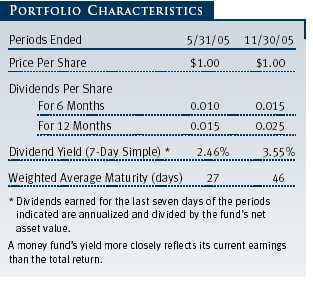
Based on the core personal consumption expenditures (PCE) deflator, which is the Fed’s preferred measure of inflation, real (inflation-adjusted) short-term interest rates are around 2.25% . Even with nominal short-term rates 325 basis points (3.25%) higher than they were 18 months ago and with real rates approaching their long-term average, central bank officials indicated after the December 13 monetary policy meeting that “some further measured policy firming is likely to be needed to keep the risks to the attainment of both sustainable economic growth and price stability roughly in balance.” In other words, we should expect at least a few more quarter-point rate hikes.
 We positioned the portfolio less defensively during our reporting period as the Fed made it clear that it would continue raising rates at a gradual pace. Given little chance that the Fed would raise rates by more than 25 basis points (0.25%) per meeting, we allowed the portfolio’s weighted average maturity to mirror closely the six-week cycle of the Fed’s monetary policy meetings as well as the average maturity of other money market mutual funds. However, as the short-term yield curve steepened toward the end of our reporting period, we extended our maturity target range to capture attractive yields offered by longer-term money market securities. Because money market yields already reflected expectations of at least two or three more quarter-point rate increases, we felt that this was an opportune time to extend our average maturity.
We positioned the portfolio less defensively during our reporting period as the Fed made it clear that it would continue raising rates at a gradual pace. Given little chance that the Fed would raise rates by more than 25 basis points (0.25%) per meeting, we allowed the portfolio’s weighted average maturity to mirror closely the six-week cycle of the Fed’s monetary policy meetings as well as the average maturity of other money market mutual funds. However, as the short-term yield curve steepened toward the end of our reporting period, we extended our maturity target range to capture attractive yields offered by longer-term money market securities. Because money market yields already reflected expectations of at least two or three more quarter-point rate increases, we felt that this was an opportune time to extend our average maturity.
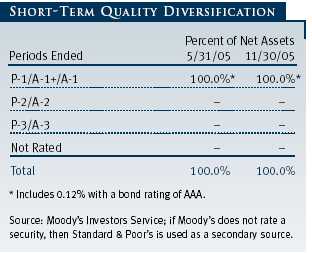 The portfolio’s credit profile continues to be very high, as indicated by the Short-Term Quality Diversification table. We continued to emphasize commercial paper and medium-term notes, which represented 71% of the portfolio at the end of November. However, the assets are well diversified by issuer and industry. Certificates of deposit represent the bulk of our other investments.
The portfolio’s credit profile continues to be very high, as indicated by the Short-Term Quality Diversification table. We continued to emphasize commercial paper and medium-term notes, which represented 71% of the portfolio at the end of November. However, the assets are well diversified by issuer and industry. Certificates of deposit represent the bulk of our other investments.
We have very little exposure to tax-exempt municipal securities in the portfolio, as higher nominal interest rates have helped alleviate the imbalances that made tax-exempt yields so appealing. We do not anticipate having any meaningful exposure to municipal issues going forward, but we will be alert to any opportunities should they arise.
OUTLOOK
Given the continuing strength of the economy and the fact that long-term interest rates have not moved substantially higher, we expect the Fed to keep raising short-term rates. Our base case forecast has the federal funds rate moving to 5.00% by the middle of 2006, at which time any further moves would depend on the outlook for economic growth and inflation. Money market yields are likely to keep rising as well.
A key advantage of a money market fund is that it can pass higher short-term rates through to shareholders more quickly than bank products with an administered rate. However, we are always mindful that our primary concerns are safety of principal and liquidity and, when these objectives are met, the highest possible yield.
Thank you for your confidence in T. Rowe Price.
Respectfully submitted,
James M. McDonald
Chairman of the fund’s Investment Advisory Committee
December 16, 2005
The committee chairman has day-to-day responsibility for managing the
portfolio and works with committee members in developing and executing
the fund’s investment program.
RISKS OF INVESTING IN MONEY MARKET SECURITIES
Since money market funds are managed to maintain a constant $1.00 share price, there should be little risk of principal loss. However, there is no assurance the fund will avoid principal losses if portfolio holdings default or are downgraded, or if interest rates rise sharply in an unusually short period. In addition, the fund’s yield will vary; it is not fixed for a specific period like the yield on a bank certificate of deposit. An investment in the fund is not insured or guaranteed by the Federal Deposit Insurance Corporation (FDIC) or any other government agency. Although a money market fund seeks to preserve the value of your investment at $1.00 per share, it is possible to lose money by investing in it.
GLOSSARY
Average maturity: The average of the stated maturity dates of a bond or money market fund’s securities. The average maturity for a money market fund is measured in days, whereas a bond fund’s average maturity is measured in years. In general, the longer the average maturity, the greater the fund’s sensitivity to interest rate changes, which means greater price fluctuation.
Basis point: One one-hundredth of a percentage point, or 0.01%.
Fed funds target rate: An overnight lending rate set by the Federal Reserve and used by banks to meet reserve requirements. Banks also use the fed funds rate as a benchmark for their prime lending rates.
Lipper average: Consists of all the mutual funds in a particular category as tracked by Lipper Inc.
This chart shows the value of a hypothetical $10,000 investment in the fund over the past 10 fiscal year periods or since inception (for funds lacking 10-year records). The result is compared with benchmarks, which may include a broad-based market index and a peer group average or index. Market indexes do not include expenses, which are deducted from fund returns as well as mutual fund averages and indexes.
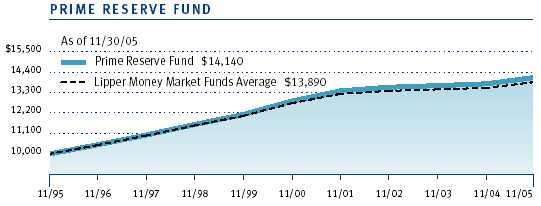
| AVERAGE ANNUAL COMPOUND TOTAL RETURN |
This table shows how the fund would have performed each year if its actual (or cumulative) returns for the periods shown had been earned at a constant rate.
 As a mutual fund shareholder, you may incur two types of costs: (1) transaction costs such as redemption fees or sales loads and (2) ongoing costs, including management fees, distribution and service (12b-1) fees, and other fund expenses. The following example is intended to help you understand your ongoing costs (in dollars) of investing in the fund and to compare these costs with the ongoing costs of investing in other mutual funds. The example is based on an investment of $1,000 invested at the beginning of the most recent six-month period and held for the entire period.
As a mutual fund shareholder, you may incur two types of costs: (1) transaction costs such as redemption fees or sales loads and (2) ongoing costs, including management fees, distribution and service (12b-1) fees, and other fund expenses. The following example is intended to help you understand your ongoing costs (in dollars) of investing in the fund and to compare these costs with the ongoing costs of investing in other mutual funds. The example is based on an investment of $1,000 invested at the beginning of the most recent six-month period and held for the entire period.
Actual Expenses
The first line of the following table (“Actual”) provides information about actual account values and actual expenses. You may use the information in this line, together with your account balance, to estimate the expenses that you paid over the period. Simply divide your account value by $1,000 (for example, an $8,600 account value divided by $1,000 = 8.6), then multiply the result by the number in the first line under the heading “Expenses Paid During Period” to estimate the expenses you paid on your account during this period.
Hypothetical Example for Comparison Purposes
The information on the second line of the table (“Hypothetical”) is based on hypothetical account values and expenses derived from the fund’s actual expense ratio and an assumed 5% per year rate of return before expenses (not the fund’s actual return). You may compare the ongoing costs of investing in the fund with other funds by contrasting this 5% hypothetical example and the 5% hypothetical examples that appear in the shareholder reports of the other funds. The hypothetical account values and expenses may not be used to estimate the actual ending account balance or expenses you paid for the period.
Note: T. Rowe Price charges an annual small-account maintenance fee of $10, generally for accounts with less than $2,000 ($500 for UGMA/UTMA). The fee is waived for any investor whose T. Rowe Price mutual fund accounts total $25,000 or more, accounts employing automatic investing, and IRAs and other retirement plan accounts that utilize a prototype plan sponsored by T. Rowe Price (although a separate custodial or administrative fee may apply to such accounts). This fee is not included in the accompanying table. If you are subject to the fee, keep it in mind when you are estimating the ongoing expenses of investing in the fund and when comparing the expenses of this fund with other funds.
You should also be aware that the expenses shown in the table highlight only your ongoing costs and do not reflect any transaction costs, such as redemption fees or sales loads. Therefore, the second line of the table is useful in comparing ongoing costs only and will not help you determine the relative total costs of owning different funds. To the extent a fund charges transaction costs, however, the total cost of owning that fund is higher.
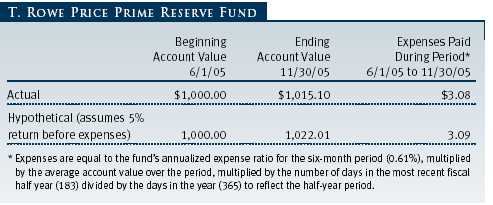
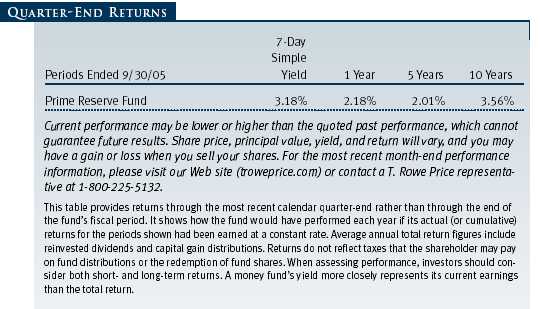 Unaudited
Unaudited
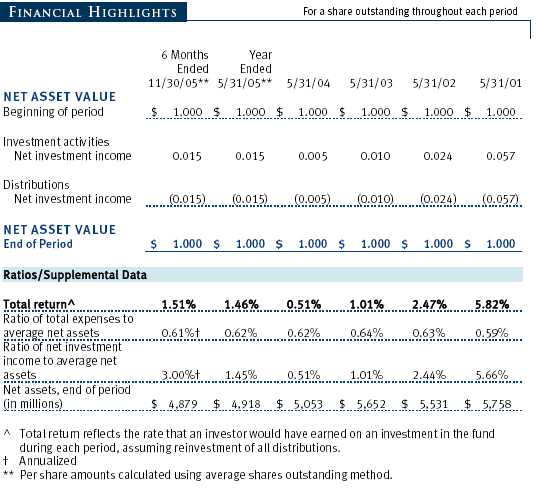
The accompanying notes are an integral part of these financial statements.
Unaudited
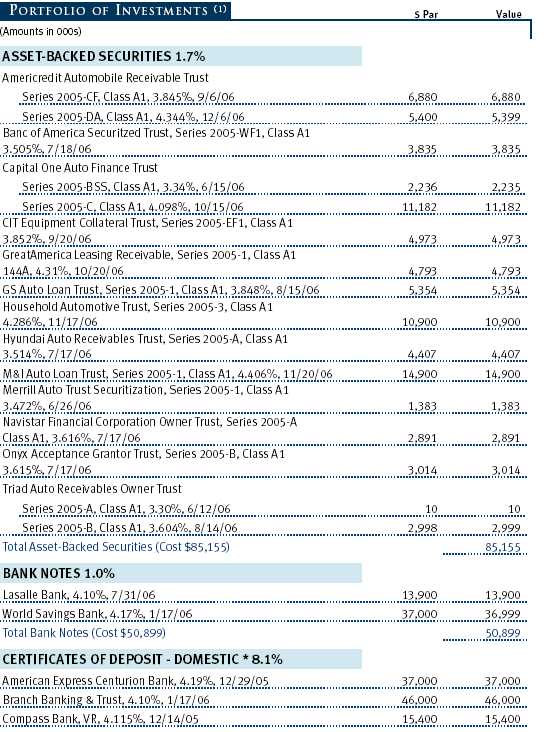
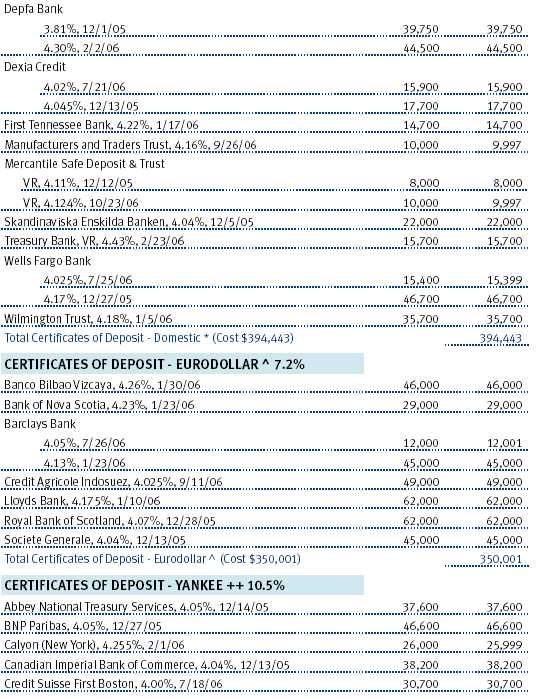
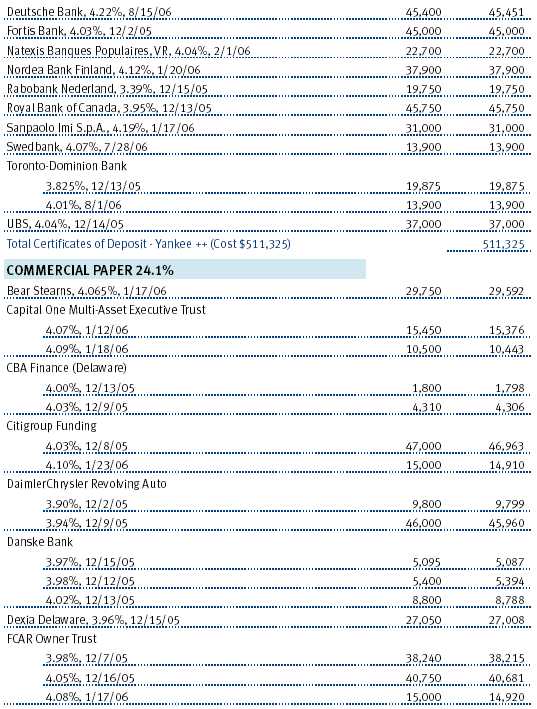
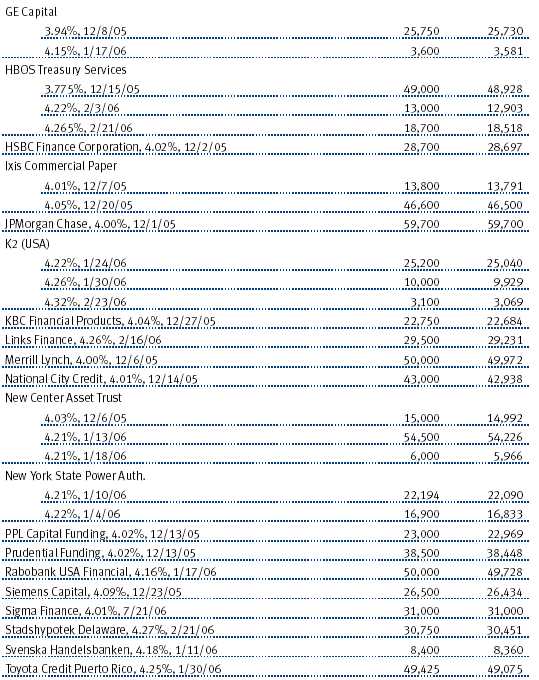
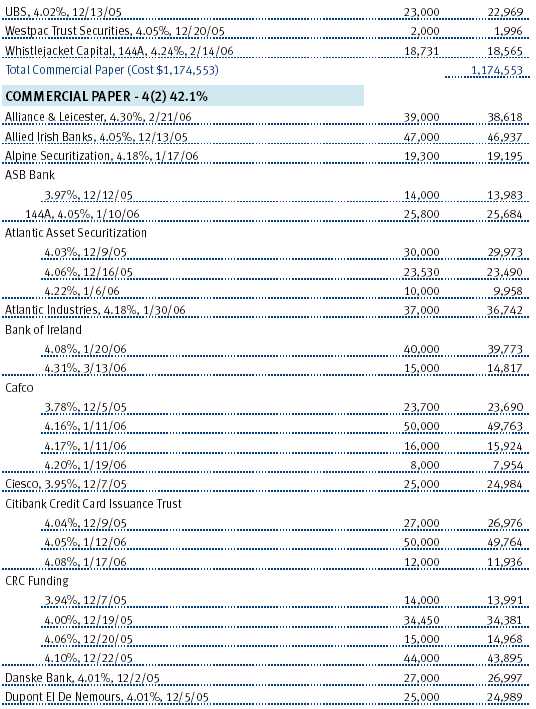
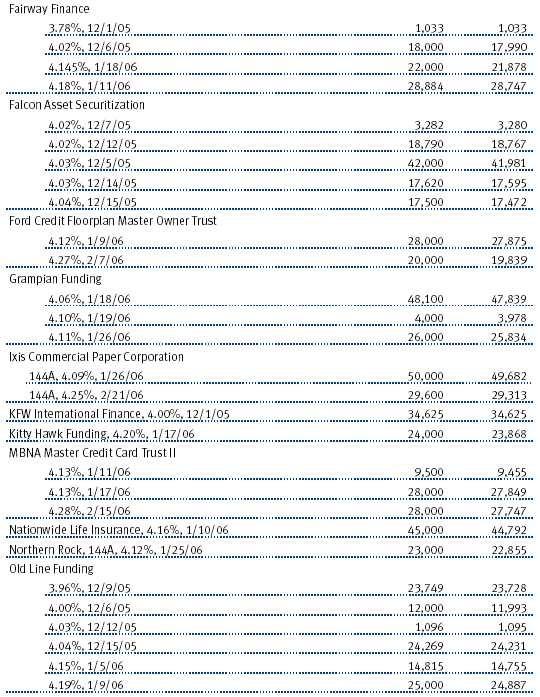
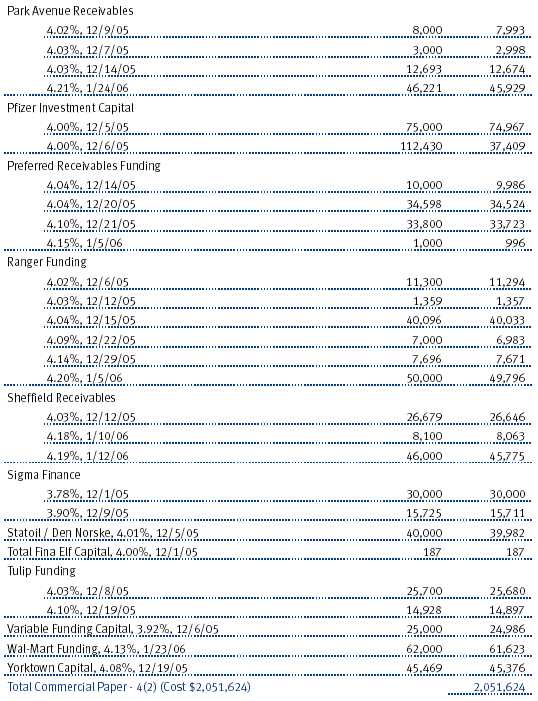

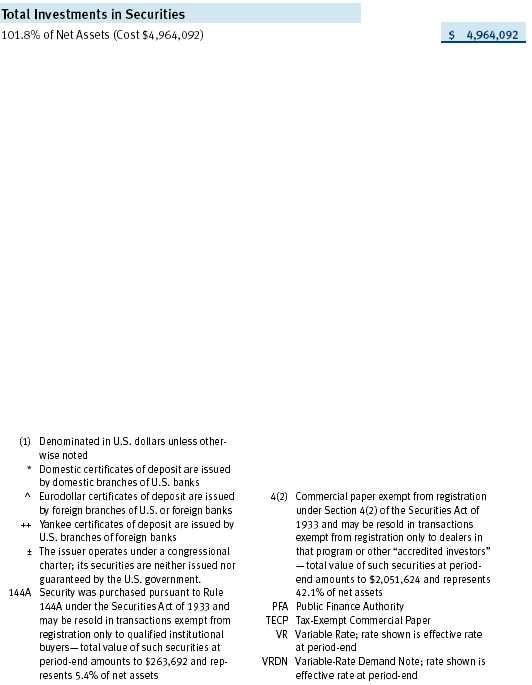

The accompanying notes are an integral part of these financial statements.
Unaudited
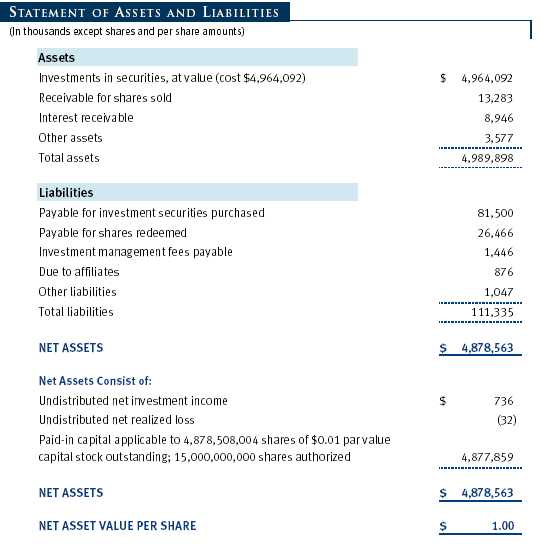
The accompanying notes are an integral part of these financial statements.
Unaudited
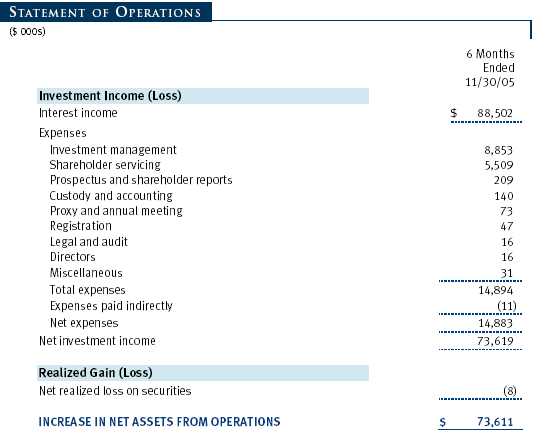
The accompanying notes are an integral part of these financial statements.
Unaudited
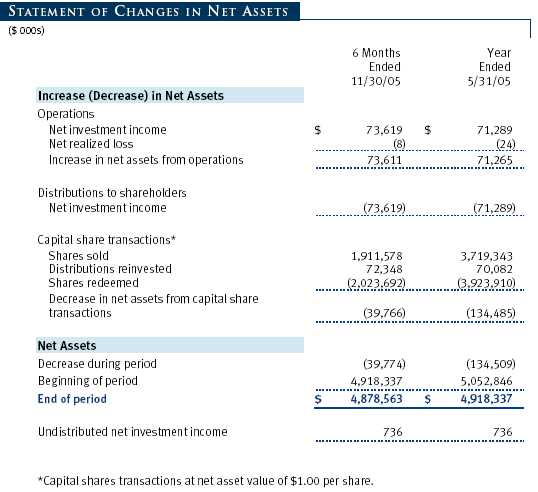
The accompanying notes are an integral part of these financial statements.
Unaudited
| NOTES TO FINANCIAL STATEMENTS |
NOTE 1 - SIGNIFICANT ACCOUNTING POLICIES
T. Rowe Price Prime Reserve Fund, Inc. (the fund) is registered under the Investment Company Act of 1940 (the 1940 Act) as a diversified, open-end management investment company. The fund commenced operations on January26, 1976. The fund seeks preservation of capital, liquidity, and, consistent with these, the highest possible current income.
The accompanying financial statements were prepared in accordance with accounting principles generally accepted in the United States of America, which require the use of estimates made by fund management. Fund management believes that estimates and security valuations are appropriate; however actual results may differ from those estimates, and the security valuations reflected in the financial statements may differ from the value the fund ultimately realizes upon sale of the securities.
Valuation Securities are valued at amortized cost. Assets and liabilities for which such valuation procedures are deemed not to reflect fair value are stated at fair value as determined in good faith by the T. Rowe Price Valuation Committee, established by the fund’s Board of Directors.
Credits The fund earns credits on temporarily uninvested cash balances at the custodian that reduce the fund’s custody charges. Custody expense in the accompanying financial statements is presented before reduction for credits, which are reflected as expenses paid indirectly.
Investment Transactions, Investment Income, and Distributions Income and expenses are recorded on the accrual basis. Premiums and discounts on debt securities are amortized for financial reporting purposes. Investment transactions are accounted for on the trade date. Realized gains and losses are reported on the identified cost basis. Paydown gains and losses are recorded as an adjustment to interest income. Distributions to shareholders are recorded on the ex-dividend date. Income distributions are declared on a daily basis and paid monthly.
NOTE 2 - INVESTMENT TRANSACTIONS
Consistent with its investment objective, the fund engages in the following practices to manage exposure to certain risks or enhance performance. The investment objective, policies, program, and risk factors of the fund are described more fully in the fund’s prospectus and Statement of Additional Information.
Restricted Securities The fund may invest in securities that are subject to legal or contractual restrictions on resale. Although certain of these securities may be readily sold, for example, under Rule 144A, others may be illiquid, their sale may involve substantial delays and additional costs, and prompt sale at an acceptable price may be difficult.
NOTE 3 - FEDERAL INCOME TAXES
No provision for federal income taxes is required since the fund intends to continue to qualify as a regulated investment company under Subchapter M of the Internal Revenue Code and distribute to shareholders all of its taxable income and gains. Federal income tax regulations differ from generally accepted accounting principles; therefore, distributions determined in accordance with tax regulations may differ in amount or character from net investment income and realized gains for financial reporting purposes. Financial reporting records are adjusted for permanent book/tax differences to reflect tax character. Financial records are not adjusted for temporary differences. The amount and character of tax-basis distributions and composition of net assets are finalized at fiscal year-end; accordingly, tax-basis balances have not been determined as of November 30, 2005.
The fund intends to retain gains to the extent of available capital loss carryforwards. As of May 31, 2005, the fund had $10,000 of unused capital loss carryforwards that expire in fiscal 2013.
At November 30, 2005, the cost of investments for federal income tax purposes was $4,964,092,000.
NOTE 4 - RELATED PARTY TRANSACTIONS
The fund is managed by T. Rowe Price Associates, Inc. (the manager or Price Associates), a wholly owned subsidiary of T. Rowe Price Group, Inc. The investment management agreement between the fund and the manager provides for an annual investment management fee, which is computed daily and paid monthly. The fee consists of an individual fund fee, equal to 0.05% of the fund’s average daily net assets, and a group fee. The group fee rate is calculated based on the combined net assets of certain mutual funds sponsored by Price Associates (the group) applied to a graduated fee schedule, with rates ranging from 0.48% for the first $1 billion of assets to 0.29% for assets in excess of $160 billion. Prior to May 1, 2005, the maximum group fee rate in the graduated fee schedule had been 0.295% for assets in excess of $120 billion. The fund’s group fee is determined by applying the group fee rate to the fund’s average daily net assets. At November 30, 2005, the effective annual group fee rate was 0.31%.
In addition, the fund has entered into service agreements with Price Associates and two wholly owned subsidiaries of Price Associates (collectively, Price). Price Associates computes the daily share price and maintains the financial records of the fund. T. Rowe Price Services, Inc., provides shareholder and administrative services in its capacity as the fund’s transfer and dividend disbursing agent. T. Rowe Price Retirement Plan Services, Inc., provides subaccounting and recordkeeping services for certain retirement accounts invested in the fund. For the six months ended November 30, 2005, expenses incurred pursuant to these service agreements were $42,000 for Price Associates, $2,805,000 for T. Rowe Price Services, Inc., and $1,062,000 for T. Rowe Price Retirement Plan Services, Inc. The total amount payable at period end pursuant to these service agreements is reflected as Due to Affiliates in the accompanying financial statements.
| INFORMATION ON PROXY VOTING POLICIES, PROCEDURES, AND RECORDS |
A description of the policies and procedures used by T. Rowe Price funds and portfolios to determine how to vote proxies relating to portfolio securities is available in each fund’s Statement of Additional Information, which you may request by calling 1-800-225-5132 or by accessing the SEC’s Web site, www.sec.gov. The description of our proxy voting policies and procedures is also available on our Web site, www.troweprice.com. To access it, click on the words “Company Info” at the top of our homepage for individual investors. Then, in the window that appears, click on the “Proxy Voting Policy” navigation button in the top left corner.
Each fund’s most recent annual proxy voting record is available on our Web site and through the SEC’s Web site. To access it through our Web site, follow the directions above, then click on the words “Proxy Voting Record” at the bottom of the Proxy Voting Policy page.
| HOW TO OBTAIN QUARTERLY PORTFOLIO HOLDINGS |
The fund files a complete schedule of portfolio holdings with the Securities and Exchange Commission for the first and third quarters of each fiscal year on Form N-Q. The fund’s Form N-Q is available electronically on the SEC’s Web site (www.sec.gov); hard copies may be reviewed and copied at the SEC’s Public Reference Room, 450 Fifth St. N.W., Washington, DC 20549. For more information on the Public Reference Room, call 1-800-SEC-0330.Item 2. Code of Ethics.
A code of ethics, as defined in Item 2 of Form N-CSR, applicable to its principal executive officer, principal financial officer, principal accounting officer or controller, or persons performing similar functions is filed as an exhibit to the registrant’s annual Form N-CSR. No substantive amendments were approved or waivers were granted to this code of ethics during the registrant’s most recent fiscal half-year.
Item 3. Audit Committee Financial Expert.
Disclosure required in registrant’s annual Form N-CSR.
Item 4. Principal Accountant Fees and Services.
Disclosure required in registrant’s annual Form N-CSR.
Item 5. Audit Committee of Listed Registrants.
Not applicable.
Item 6. Schedule of Investments.
Not applicable. The complete schedule of investments is included in Item 1 of this Form N-CSR.
Item 7. Disclosure of Proxy Voting Policies and Procedures for Closed-End Management Investment Companies.
Not applicable.
Item 8. Portfolio Managers of Closed-End Management Investment Companies.
Not applicable.
Item 9. Purchases of Equity Securities by Closed-End Management Investment Company and Affiliated Purchasers.
Not applicable.
Item 10. Submission of Matters to a Vote of Security Holders.
Not applicable.
Item 11. Controls and Procedures.
(a) The registrant’s principal executive officer and principal financial officer have evaluated the registrant’s disclosure controls and procedures within 90 days of this filing and have concluded that the registrant’s disclosure controls and procedures were effective, as of that date, in ensuring that information required to be disclosed by the registrant in this Form N-CSR was recorded, processed, summarized, and reported timely.
(b) The registrant’s principal executive officer and principal financial officer are aware of no change in the registrant’s internal control over financial reporting that occurred during the registrant’s second fiscal quarter covered by this report that has materially affected, or is reasonably likely to materially affect, the registrant’s internal control over financial reporting.
Item 12. Exhibits.
(a)(1) The registrant’s code of ethics pursuant to Item 2 of Form N-CSR is filed with the registrant’s annual Form N-CSR.
(2) Separate certifications by the registrant's principal executive officer and principal financial officer, pursuant to Section 302 of the Sarbanes-Oxley Act of 2002 and required by Rule 30a-2(a) under the Investment Company Act of 1940, are attached.
(3) Written solicitation to repurchase securities issued by closed-end companies: not applicable.
(b) A certification by the registrant's principal executive officer and principal financial officer, pursuant to Section 906 of the Sarbanes-Oxley Act of 2002 and required by Rule 30a-2(b) under the Investment Company Act of 1940, is attached.
| | |
SIGNATURES |
| |
| | Pursuant to the requirements of the Securities Exchange Act of 1934 and the Investment |
| Company Act of 1940, the registrant has duly caused this report to be signed on its behalf by the |
| undersigned, thereunto duly authorized. |
| |
| T. Rowe Price Prime Reserve Fund, Inc. |
| |
| By | /s/ James S. Riepe |
| | James S. Riepe |
| | Principal Executive Officer |
| |
| Date | January 13, 2006 |
| |
| |
| | Pursuant to the requirements of the Securities Exchange Act of 1934 and the Investment |
| Company Act of 1940, this report has been signed below by the following persons on behalf of |
| the registrant and in the capacities and on the dates indicated. |
| |
| |
| By | /s/ James S. Riepe |
| | James S. Riepe |
| | Principal Executive Officer |
| |
| Date | January 13, 2006 |
| |
| |
| |
| By | /s/ Joseph A. Carrier |
| | Joseph A. Carrier |
| | Principal Financial Officer |
| |
| Date | January 13, 2006 |

























